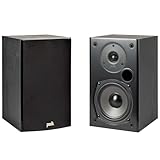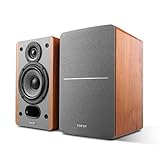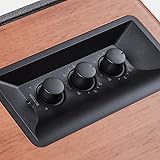 Advertising Disclosure
Advertising DisclosureBookshelf Speakers Comparison - December 2025

Our Top 3 Picks
Here are the top 3 recommended products with more information to help you find the right product for you9.8
1EdifierEdifier R1280T Powered Bookshelf Speakers - 2.0 Active Near Field Studio Monitor Speaker - Wooden Enclosure - 42 Watts RMS Power
9.6 materials Quality9.6 lasts a long time9.4 audio qualityWhy we love it
Great sound quality
Can connect to two devices at once
Comes with a remote
9.7
2Polk AudioPolk Audio T15 Home Theater and Stereo Bookshelf Speakers – Deep Bass Response, Dolby and DTS Surround, Wall-Mountable, Pair, Black
9.6 materials Quality9.6 worth the money9.6 lasts a long timeWhy we love it
Polks T series speakers are designed to produce superior home theater sound quality with immersive surround sound.
The T series speakers can be used as front, left right, or surround speakers in a full fledged 5.1 home theater setup.
Polks T series speakers are a great value and offer premium acoustics, high quality construction, and easy setup.
9.6
3KlipschKlipsch R-41M Reference Bookshelf Speakers (Pair), Black
9.8 audio quality9.8 materials Quality9.8 worth the moneyWhy we love it
Good sound quality
Good power handling
Good sensitivity

Bookshelf Speakers Buyer's Guide
 Written by Jim Williams
Written by Jim WilliamsIntroduction
Bookshelf speakers provide a great way to blast your favorite tunes or listen to your favorite audiobooks in style. Whether you’re looking for a powerful sound system to fill your living room or a compact set of speakers to fit on a desk, the right bookshelf speakers can make all the difference. Before you start shopping, it’s important to understand the different features and types of bookshelf speakers available. This buying guide will explain the main features to look out for, as well as the different types of bookshelf speakers you can choose from.
Power Output
Power output is one of the most important factors to consider when buying bookshelf speakers. The wattage output dictates how loud the speakers can get and how far the sound will travel. Low-power speakers won’t be able to fill a large room, but they can be perfect for a small office or bedroom. If you want your music to be heard from the other side of the house, you’ll need to look for high-power speakers that can deliver up to 500 watts or more.
Frequency Response
Frequency response is another important feature to consider. Frequency response is measured in Hertz (Hz) and it determines the range of sound the speakers can produce. Generally, larger bookshelf speakers will have a wider range of frequency response, allowing them to produce deeper bass sounds and higher-pitched sounds. Smaller speakers will usually have a narrower frequency response, so they won’t be able to produce the same range of sound.

Crossover Frequency
The crossover frequency is the point at which the sound is divided between the woofer and the tweeter. The higher the crossover frequency, the higher the sound will be. Low crossover frequencies will produce a deep, rich sound, while high crossover frequencies will create a crisp, clear sound. It’s important to choose a bookshelf speaker with the right crossover frequency to ensure the sound is balanced and clear.
Types of Bookshelf Speakers
Bookshelf speakers come in a variety of shapes and sizes, so it’s important to know which type is best for your needs. Two-way speakers are the most common type, and they feature two drivers (a woofer and a tweeter) to produce a full range of sound. Three-way speakers are larger and more powerful, as they feature three drivers (two woofers and a tweeter). Finally, active speakers come with an amplifier built-in, so they don’t require an external amplifier.
Conclusion
When shopping for bookshelf speakers, it’s important to consider the power output, frequency response, and crossover frequency. It’s also important to consider the type of speaker you need, as two-way speakers are the most common type but three-way speakers and active speakers can also offer more powerful sound. By understanding the features and types of bookshelf speakers available, you can find the perfect set of speakers for your needs.

Our ranking system
At bestchoice.com, our team curates a selection of top products from a vast array available online, using a sophisticated ranking system based on carefully defined criteria.While traditional hands-on testing has its merits, our use of AI technology offers distinct advantages. AI allows us to process and analyze vast amounts of data from multiple sources, providing a comprehensive view that goes beyond what manual testing can achieve. This approach enables us to deliver insights that are aligned with current trends and consumer preferences, ensuring our reviews are both relevant and up-to-date.
Features
Our AI-driven analysis examines key attributes, capabilities, and other critical factors tailored to each product category. This method allows us to assess effectiveness from various perspectives, ensuring a well-rounded evaluation.
Consumer Reviews
We aggregate and evaluate consumer feedback from across the internet, giving weight to ratings and reviews that reflect the most reliable insights. AI enhances this process by filtering and prioritizing data, offering a balanced view without the need for direct personal endorsements.
Popularity
Our system also considers the popularity of products, analyzing factors such as market presence, reputation, and user satisfaction. By leveraging AI, we capture a comprehensive picture of a product's standing in the market, which may not always be evident through traditional testing.
Value for money
AI allows us to compare products based on attributes like price, specifications, and user feedback, helping to determine their value for money. This data-driven approach offers an efficient and reliable way to assess how products stack up against one another in terms of cost-effectiveness.



































